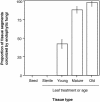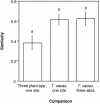Fungal endophytes limit pathogen damage in a tropical tree
- PMID: 14671327
- PMCID: PMC307622
- DOI: 10.1073/pnas.2533483100
Fungal endophytes limit pathogen damage in a tropical tree
Abstract
Every plant species examined to date harbors endophytic fungi within its asymptomatic aerial tissues, such that endophytes represent a ubiquitous, yet cryptic, component of terrestrial plant communities. Fungal endophytes associated with leaves of woody angiosperms are especially diverse; yet, fundamental aspects of their interactions with hosts are unknown. In contrast to the relatively species-poor endophytes that are vertically transmitted and act as defensive mutualists of some temperate grasses, the diverse, horizontally transmitted endophytes of woody angiosperms are thought to contribute little to host defense. Here, we document high diversity, spatial structure, and host affinity among foliar endophytes associated with a tropical tree (Theobroma cacao, Malvaceae) across lowland Panama. We then show that inoculation of endophyte-free leaves with endophytes isolated frequently from naturally infected, asymptomatic hosts significantly decreases both leaf necrosis and leaf mortality when T. cacao seedlings are challenged with a major pathogen (Phytophthora sp.). In contrast to reports of fungal inoculation inducing systemic defense, we found that protection was primarily localized to endophyte-infected tissues. Further, endophyte-mediated protection was greater in mature leaves, which bear less intrinsic defense against fungal pathogens than do young leaves. In vitro studies suggest that host affinity is mediated by leaf chemistry, and that protection may be mediated by direct interactions of endophytes with foliar pathogens. Together, these data demonstrate the capacity of diverse, horizontally transmitted endophytes of woody angiosperms to play an important but previously unappreciated role in host defense.
Figures





References
-
- Berbee, M. L. (2001) Physiol. Mol. Plant Pathol. 59, 165–187.
-
- Alexopoulos, C. J., Mims, C. W. & Blackwell, M. (1996) Introductory Mycology (Wiley, New York).
-
- Clay, K. & Holah J. (1999) Science 285, 1742–1744. - PubMed
-
- Packer, A. & Clay, K. (2000) Nature 404, 278–228. - PubMed
-
- Gilbert, G. S. (2002) Annu. Rev. Phytopathol. 40, 13–43. - PubMed
Publication types
MeSH terms
LinkOut - more resources
Full Text Sources

